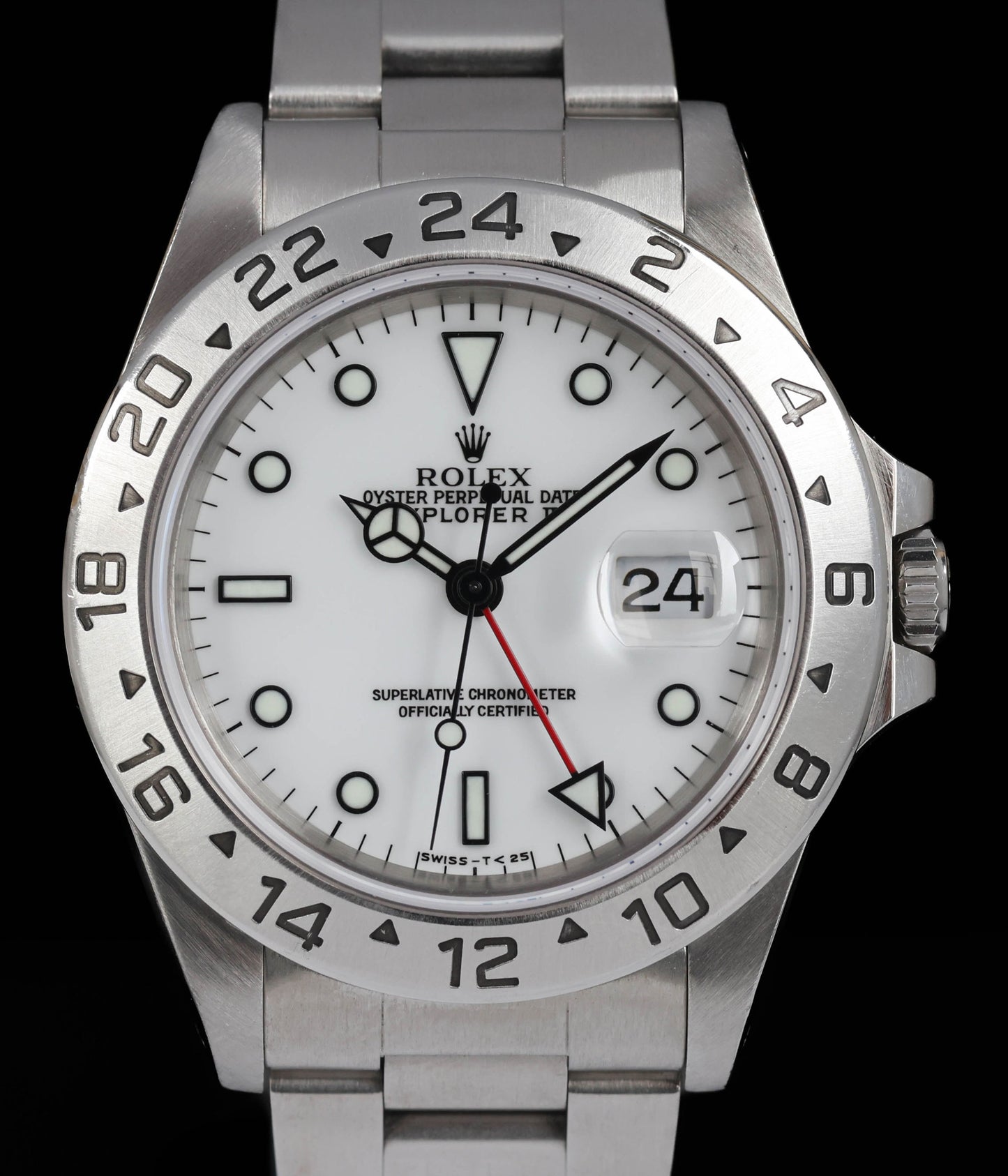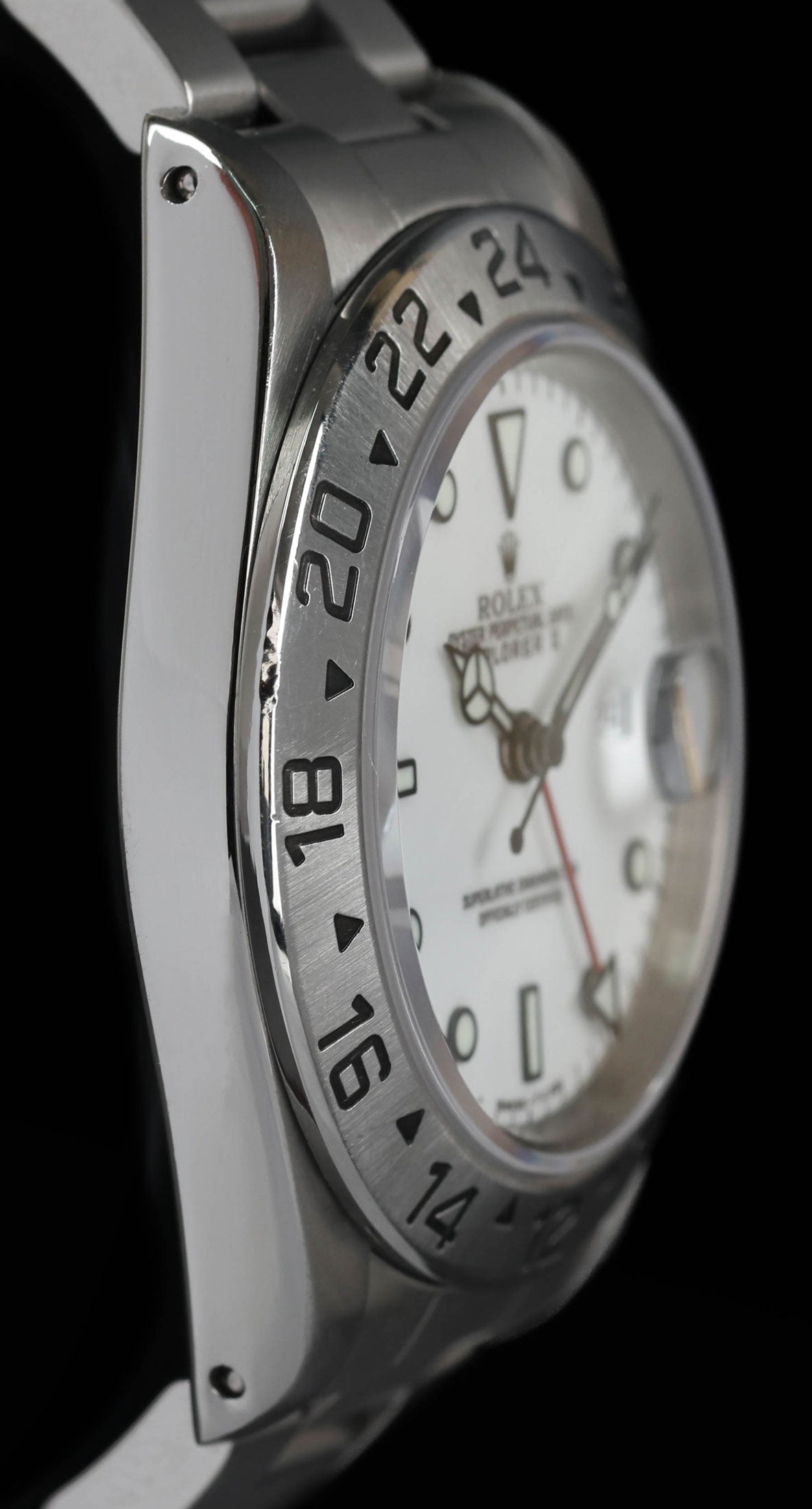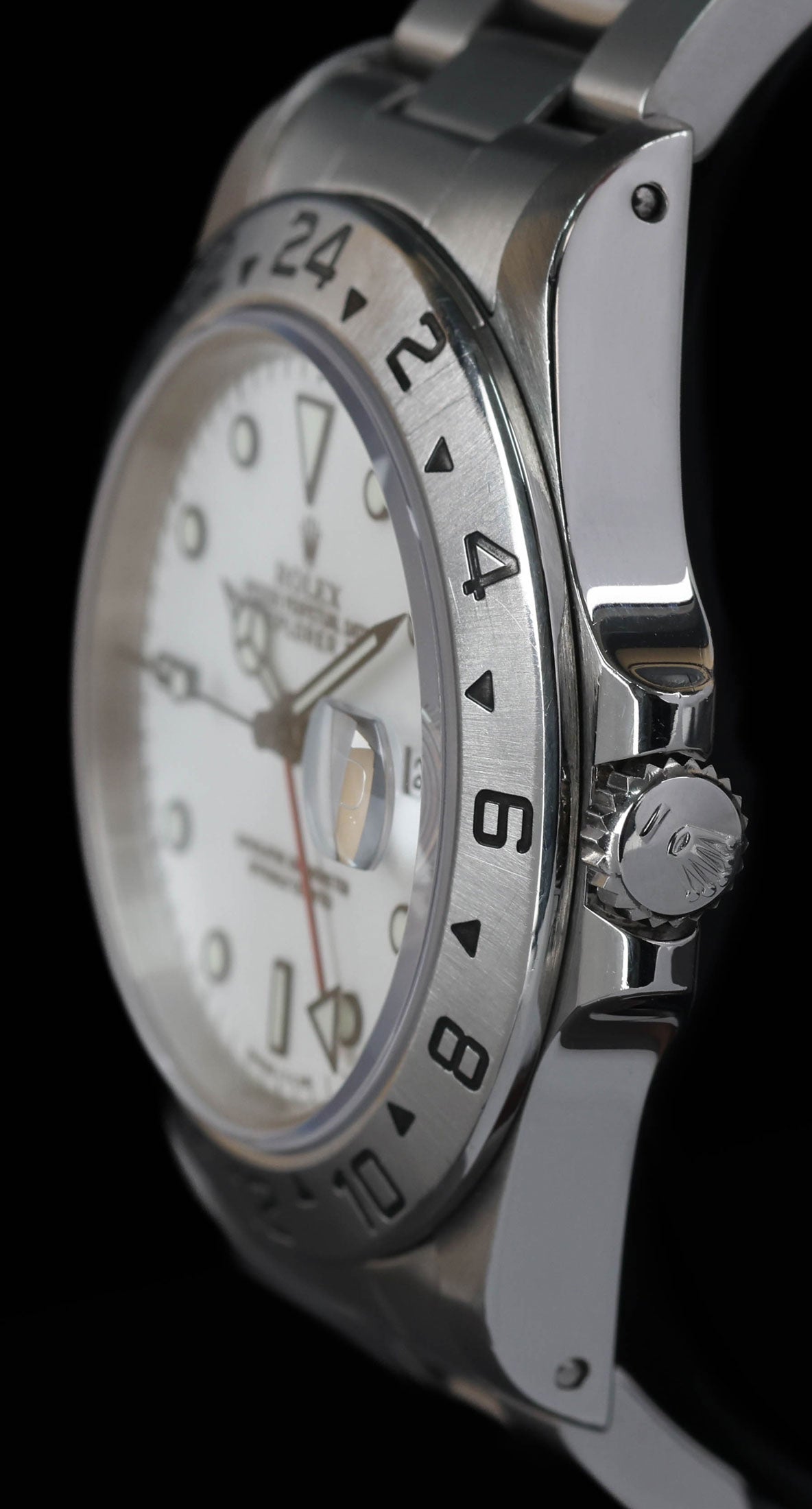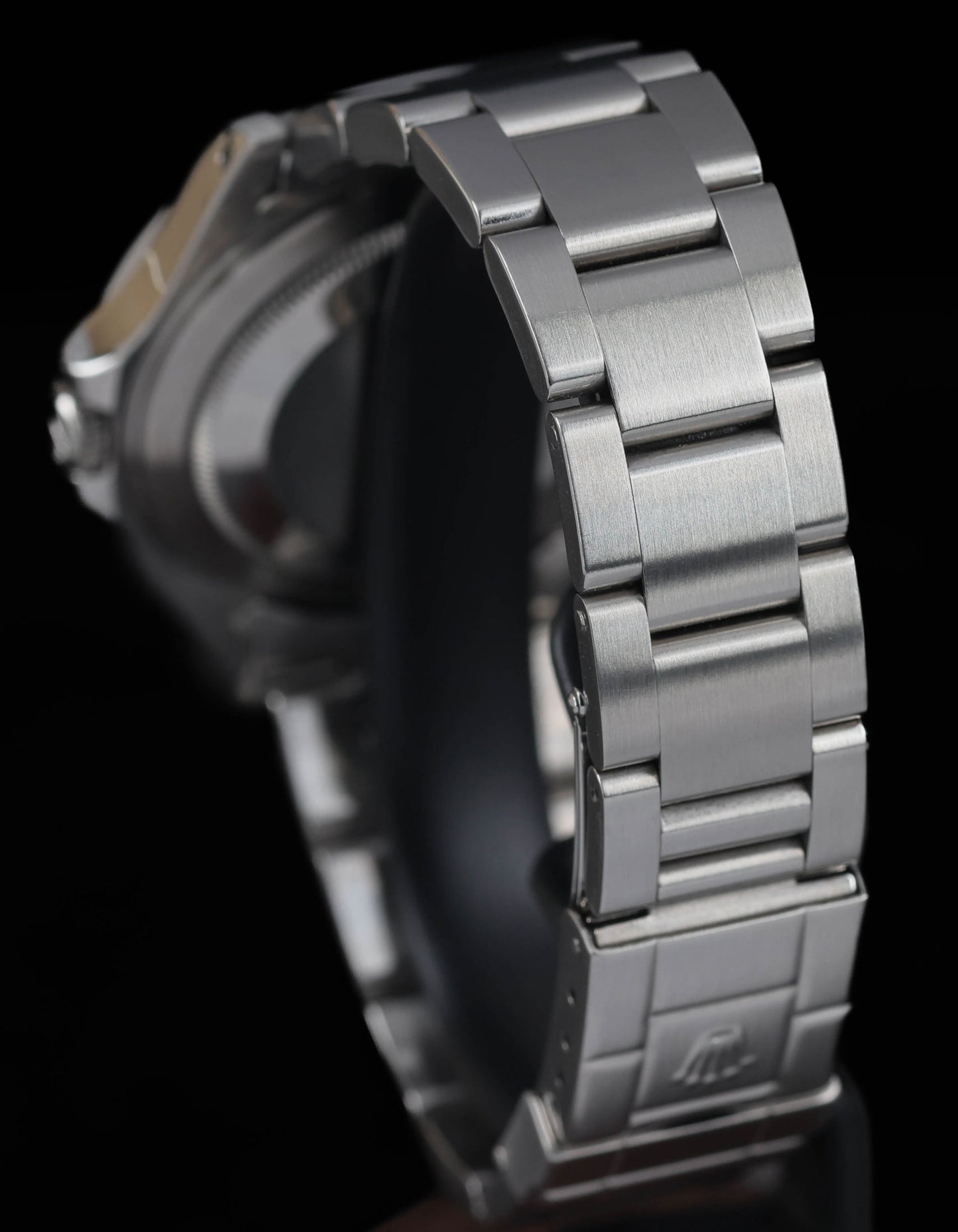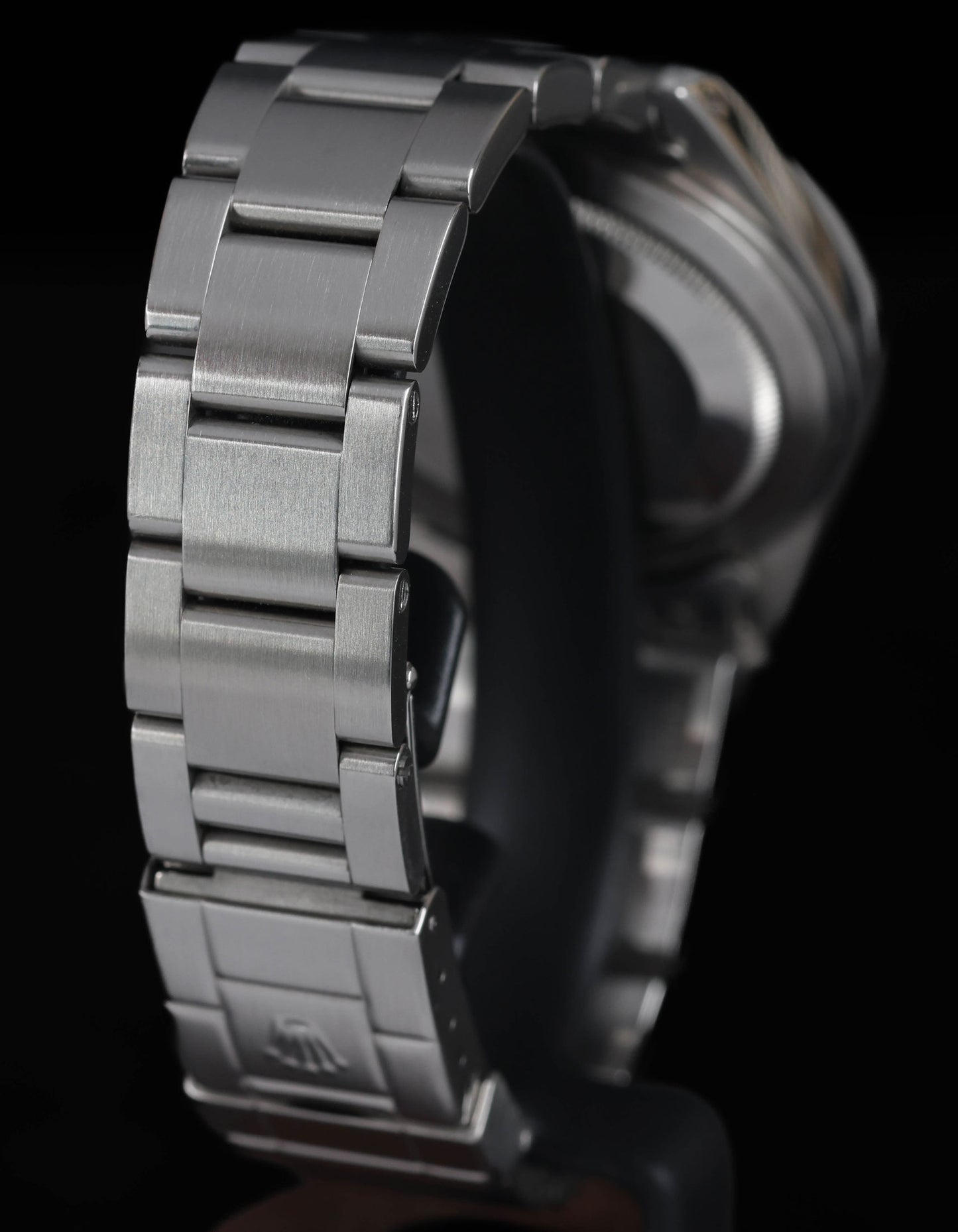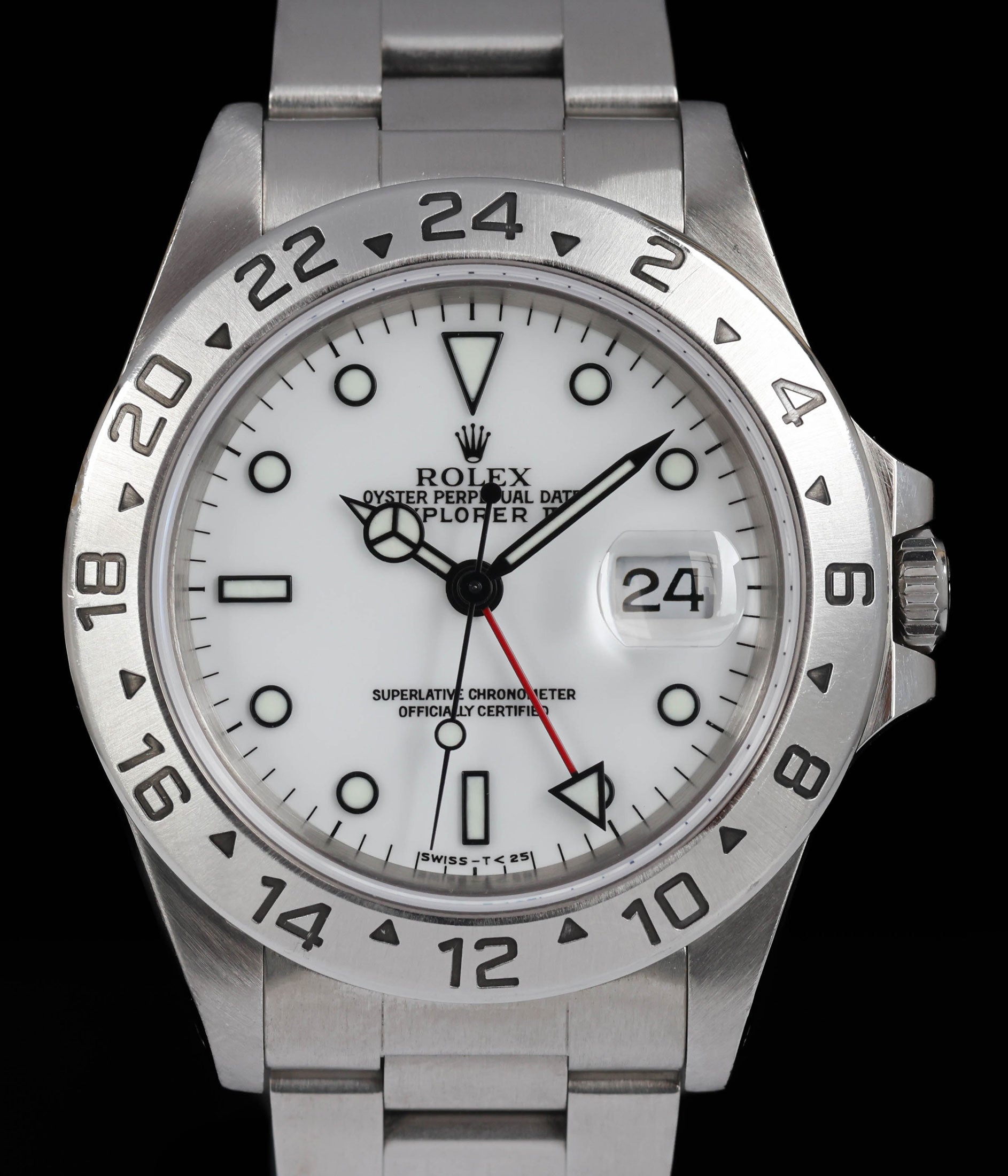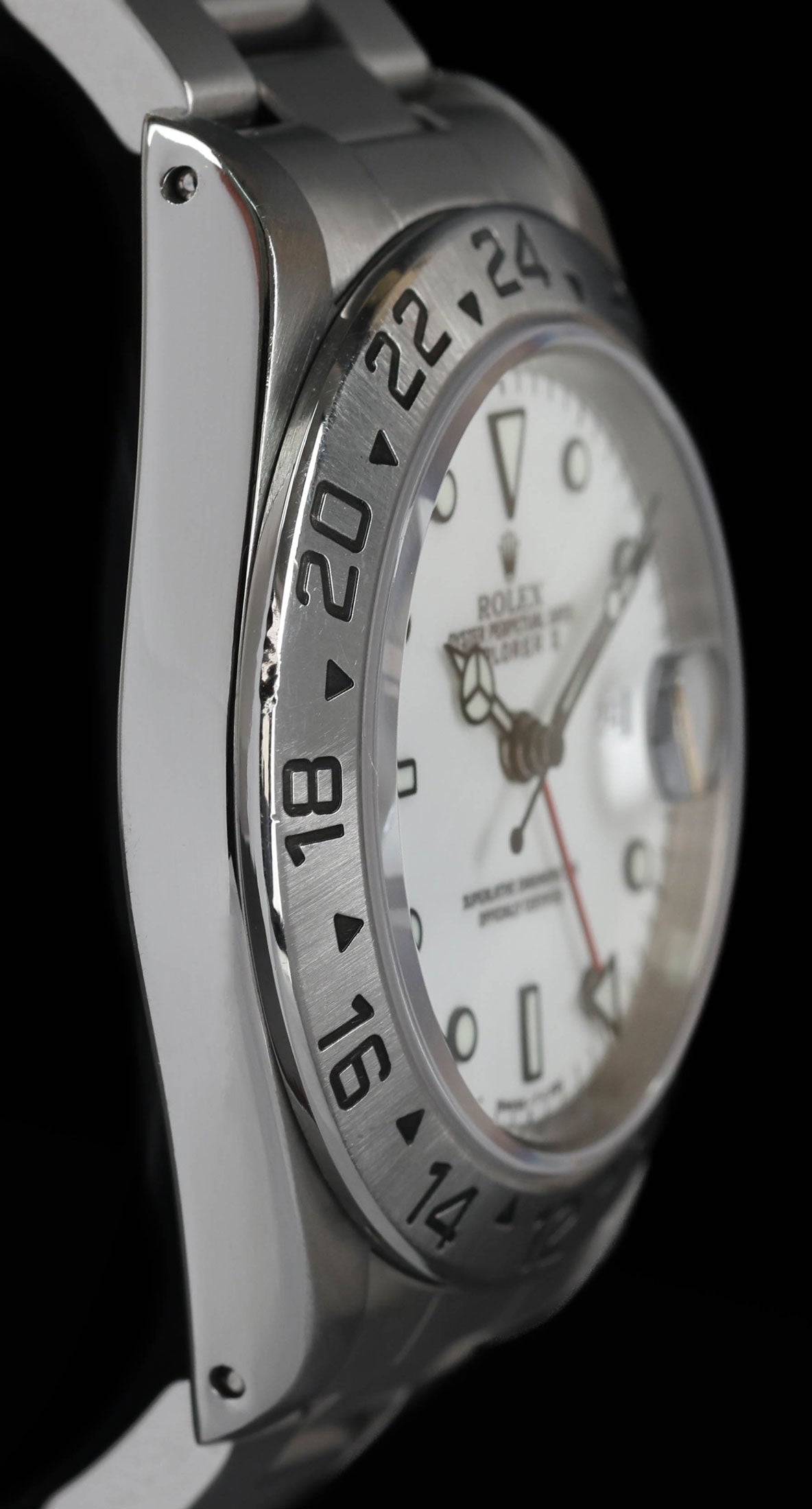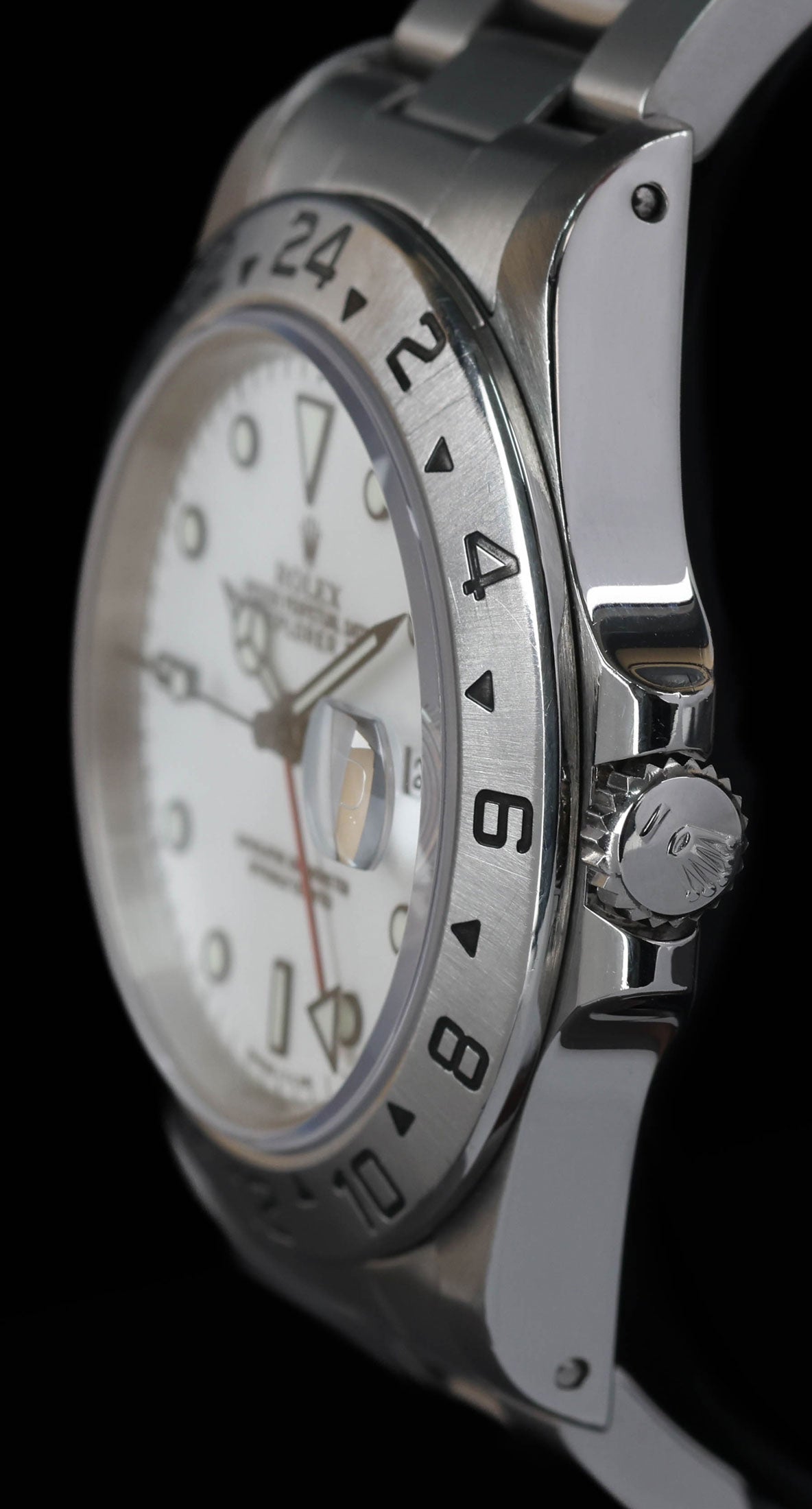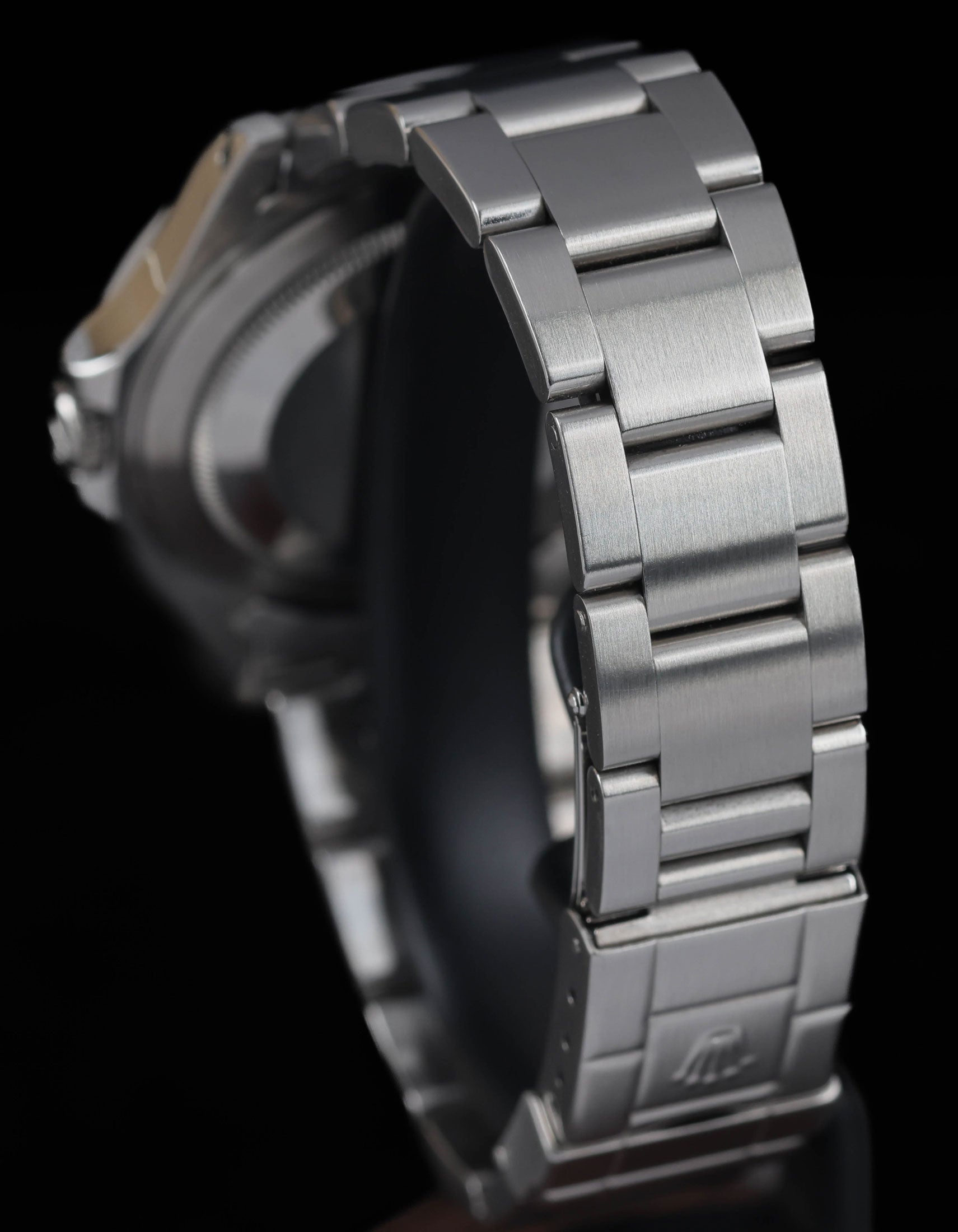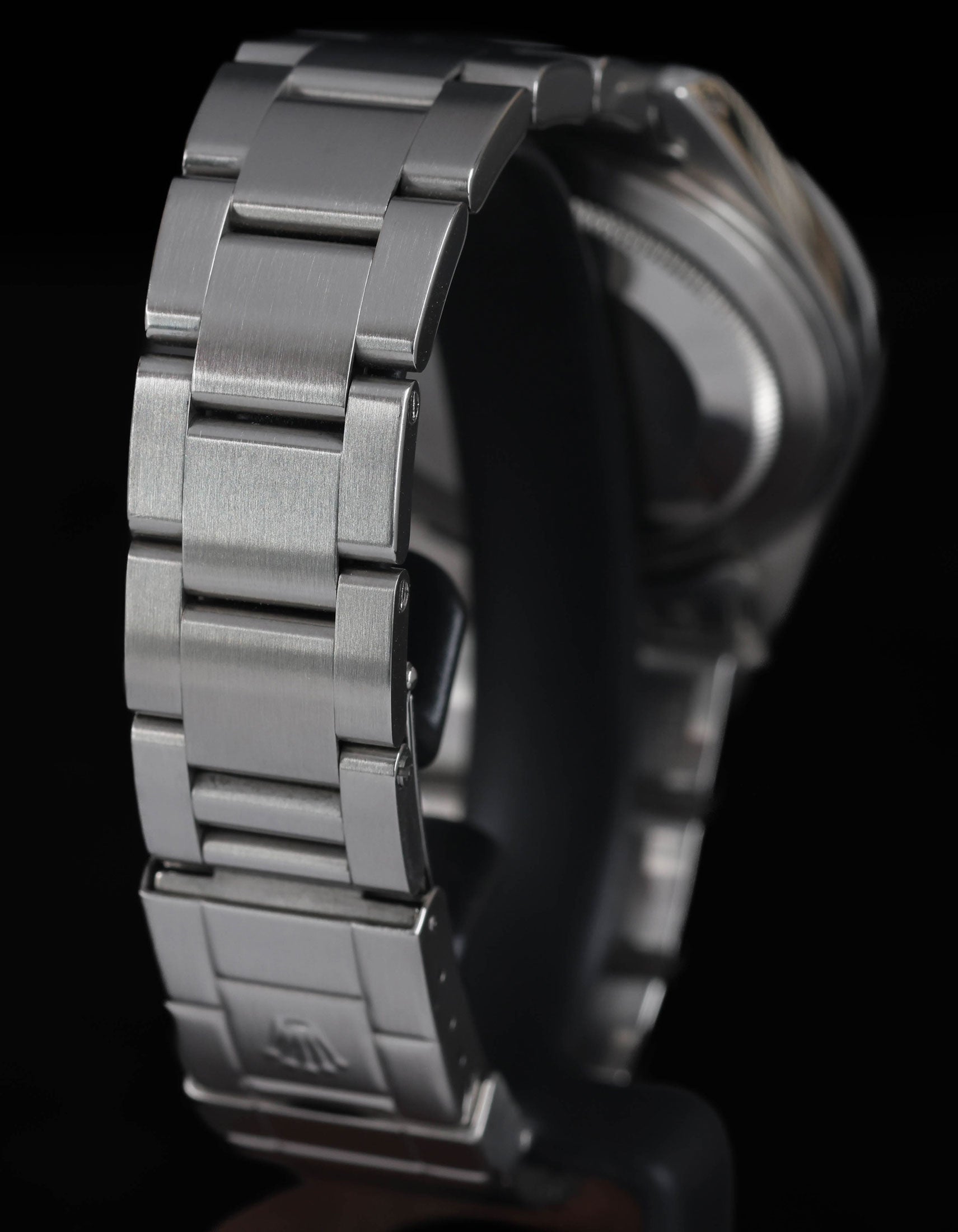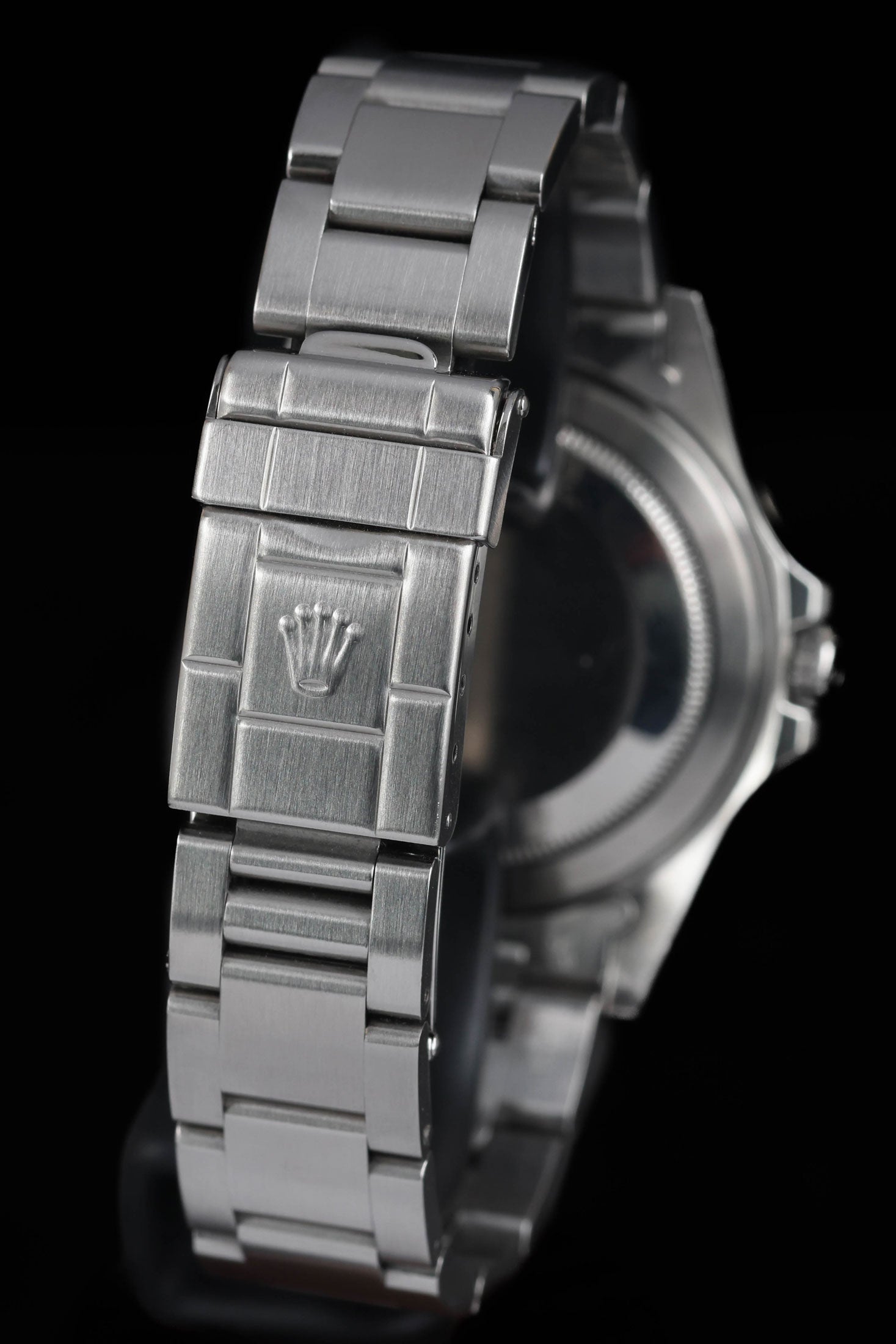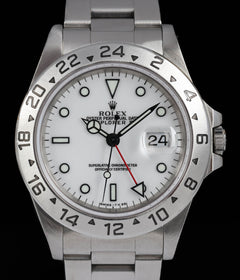Crown Vintage
Rolex Explorer II 16570 Polar 40MM 1997
Rolex Explorer II 16570 Polar 40MM 1997
Couldn't load pickup availability
This 40mm Rolex Explorer II is the sought-after “Polar” variant, featuring the crisp white dial that distinguishes it from the black-dial version. The stainless steel case shows only minimal wear, retaining a clean profile, while the matching Oyster bracelet exhibits little to no stretch. Dial and hands are flawless, ensuring excellent legibility and underscoring the watch’s robust heritage as a trusty adventurer’s companion.
Share
Why we love this watch
Why we love this watch
The Rolex Explorer II 16570 Polar
The Rolex Explorer II is often lauded as one of the brand’s most functionally focused tool watches—purpose-built for adventurers who traverse some of the most challenging environments on Earth. Since its introduction in 1971 with the inaugural Ref. 1655, the Explorer II has evolved to meet the practical needs of professional explorers, spelunkers, and polar expedition teams.
The reference 16570, introduced in 1989 and produced until around 2011, stands as a quintessential example of the model’s emphasis on rugged reliability and no-nonsense utility. Among its variations, the white-dial or “Polar” version is especially revered by collectors.
1. The Genesis of the Rolex Explorer II
1.1 The Explorer Legacy
Before diving into the Explorer II, it helps to understand the broader Explorer lineage, which dates back to 1953. That year, Rolex formally launched the first Explorer (Ref. 6350), capitalising on the brand’s association with Sir Edmund Hillary and Tenzing Norgay’s successful summit of Mount Everest. Though Hillary and Norgay wore earlier Rolex models—often described in marketing as “Pre-Explorer” watches—the Explorer line was forever linked to feats of exploration and mountaineering prowess.
The success of the Explorer established Rolex’s bona fides in building tool watches that excelled in demanding, extreme conditions. By the late 1960s, the brand aimed to address another set of professionals: spelunkers (cavers) and those operating in low-light or no-light environments. Thus, the concept for the Explorer II took shape.
1.2 Birth of the Explorer II Ref. 1655
Launched in 1971, the Explorer II Ref. 1655—often called the “Steve McQueen” or “Freccione” (Italian for “arrow”)—was tailor-made for subterranean explorers who could not rely on natural light to distinguish between day and night. In addition to its fixed 24-hour bezel, the Ref. 1655 had an orange 24-hour hand that traversed the dial once every 24 hours. This feature provided an unambiguous method of differentiating day from night, a crucial advantage for cavers who might otherwise lose track of their sleep cycles.
Though overshadowed in popularity at times by Rolex’s other sports models (notably the Submariner and GMT-Master), the Explorer II established a unique identity. Its design ethos was to be functional above all else, with a rugged case, legible dial, and an additional time-telling capability that aided explorers in harsh conditions.
2. The Evolution to Reference 16570
2.1 Intermediate Steps: Ref. 16550
Between the original 1655 and the introduction of the 16570, Rolex released the Explorer II Ref. 16550 in the mid-1980s. This transitional model introduced features such as sapphire crystal, an updated Caliber 3085 movement, and the option of a white dial variant. However, the paint used for the white dial sometimes developed a creamy patina, and the earliest examples had issues with the hour markers turning a tone that didn’t match the intended design. Despite these hiccups, the 16550 laid the groundwork for the significant improvements that would arrive with the next reference.
2.2 Debut of the 16570
Introduced in 1989, the Explorer II Ref. 16570 incorporated subtle yet meaningful refinements. Externally, it had a slightly sleeker case design, retaining the fixed 24-hour bezel but updating it cosmetically. Internally, it was powered by the Caliber 3185 (and, in some late production runs, the Caliber 3186). Rolex had already perfected the 3000-series movements in other models, and the Explorer II benefited from that platform’s well-earned reputation for durability and accuracy.
The 16570 was produced until around 2011, making it one of the longer-running Explorer II references in Rolex’s catalog. It coexisted with a black dial version, but the white dial—dubbed the “Polar”—proved particularly popular for its stark, high-contrast aesthetic. This model would remain effectively the last 40 mm Explorer II before Rolex replaced it with the 42 mm Ref. 216570.
3. The Polar Dial: Defining Aesthetics and Legibility
3.1 A Striking Contrast
The nickname “Polar” for the white-dial Explorer II is more than just a nod to its color—it also alludes to the watch’s robust practicality in icy, barren regions where the sun may not rise or set for extended periods. The dial’s crisp white surface sets it apart from the black dial of the other Explorer II variant, offering an entirely different visual character. Dark, boldly outlined hour markers ensure excellent legibility, while the black surrounds around the hands further amplify their contrast against the white backdrop.
3.2 Lume and Hour Markers
Over the 16570’s production run, Rolex employed tritium, LumiNova, and eventually Super-LumiNova as luminous materials. Each iteration is marked on the dial:
• “T<25” or “Swiss–T<25” for tritium
• “Swiss” for LumiNova (a short-lived transitional period)
• “Swiss Made” for Super-LumiNova
Collectors often pay close attention to these dial designations, as they can place a given watch within a specific production period and indicate the watch’s luminous properties.
3.3 Subtle Differences Over Time
While the core design of the Polar dial remained consistent, minor tweaks appeared over the years—changes in the typeface, the thickness of the hour markers, or the alignment of text. Though subtle, these variations can intrigue dedicated aficionados who focus on so-called “dial evolution.” Such details have contributed to the 16570’s robust collector community, continually seeking that perfect or unusual dial variant.
4. Main Use: From Low-Light Conditions to Modern-Day Versatility
4.1 Origins of Utility
Rolex’s original pitch for the Explorer II was aimed primarily at cavers and polar explorers—individuals working in environments where day and night could blend into one. By setting the 24-hour hand to local time, a user in these dark or sunless conditions could discern day from night at a glance. The watch’s fixed stainless steel bezel, marked with a 24-hour scale, was rugged and purpose-driven, removing any additional complexity that might hinder performance.
Though caving was the classic use case, the Explorer II also garnered interest among scientific researchers in polar regions, where the sun can remain visible around the clock during summers (the “midnight sun”) or barely rise at all in the depths of winter. The watch effectively provided a reliable reference point for a standard 24-hour cycle, ensuring a semblance of normal routine in these extreme locales.
4.2 The Modern Landscape
In contemporary times, few owners of the Explorer II (16570 or otherwise) rely on it specifically for caving or polar expeditions. Instead, the watch has taken on an all-purpose role that leverages its robust design and multiple time-zone capabilities. Like the GMT-Master II, the Explorer II’s 24-hour hand can be set independently from the main hour hand (especially with the Caliber 3185 or 3186), enabling travellers to keep track of home time while adjusting local time on the main dial.
Many watch collectors also appreciate the 16570 for its discreet yet distinct personality. Unlike the Submariner or GMT-Master, the Explorer II is often viewed as a quieter statement—an under-the-radar Rolex sports model.
5. Technical Specifications and Movement
5.1 Caliber 3185 and 3186
Most Explorer II Ref. 16570 models house the Caliber 3185, an automatic movement with a 28,800-vph beat rate and a roughly 48-hour power reserve. Renowned for its robustness and accuracy, the 3185 also powered the GMT-Master II of the era. Toward the end of the 16570’s production in the late 2000s, Rolex introduced the Caliber 3186—a very similar movement but featuring Rolex’s Parachrom hairspring and marginally refined gear train. Some late “M” and “V” serial 16570 watches might contain the 3186, and these can command a premium among collectors for their relative rarity.
5.2 Case Dimensions and Features
The 16570 case measures 40 mm in diameter—a sweet spot for many collectors who prefer the classic size of Rolex sport watches. It is fashioned from 904L stainless steel, Rolex’s proprietary Oystersteel, which offers heightened corrosion resistance and a pleasing ability to retain polish or brushed finishes. Water-resistant to 100 metres (330 feet), the watch is suitable for most aquatic activities short of serious scuba diving. A screw-down crown and solid caseback keep dust, moisture, and grit from interfering with the movement.
5.3 Oyster Bracelet
Typically fitted to the three-link Oyster bracelet, the Explorer II 16570 benefits from the same robust design found across Rolex’s professional lineup. Over its production run, Rolex made small adjustments to the bracelet—such as the transition from hollow end links to solid end links, and the introduction of slightly different clasp engravings. Regardless of iteration, the Oyster bracelet on the Explorer II is comfortable, sturdy, and adjustable, mirroring the brand’s commitment to practical engineering.
6. Collectability and Variations
6.1 Early vs. Late Production Models
As noted, changes in luminous materials, dial text, and even the movement (3185 vs. 3186) help differentiate early from late 16570 Explorer IIs. Collectors sometimes seek out specific “Tritium dial” pieces for their vintage charm, or chase one of the transitional LumiNova or Super-LumiNova references. Late production 16570 “Polar” models with the 3186 caliber are considered by some to be the best expression of the reference, bridging vintage size and design with more modern mechanical touches.
6.2 The Appeal of the Polar Dial
Beyond the distinctive look, the white-dial Explorer II also tends to stand out within Rolex’s sports watch family, which often leans toward black or dark dials. The stark luminescent hour markers and the black surrounds on the “Polar” version exemplify strong legibility. Although there is a black-dial 16570, many fans find that the white dial underscores the watch’s identity as a specialist piece for extreme or unusual conditions.
6.3 Pricing and Market Demand
While the Explorer II traditionally remained overshadowed by the Submariner and GMT-Master in mainstream popularity, collector interest in the reference has steadily climbed over the past decade. Many watch enthusiasts regard the 16570 as an accessible “hidden gem”—a 40 mm Rolex sports watch with robust in-house movement, a unique fixed bezel aesthetic, and a storied heritage that sets it apart from more common references. Consequently, prices on the secondary market for well-preserved Polar dials have steadily increased, although still often below the cost of comparable vintage Submariners or GMT-Masters.
7. Wearing the 16570 Polar: Practical Style
7.1 An Everyday Tool Watch
Despite its specialized heritage, the 16570 Polar is surprisingly versatile. Its moderate thickness, comfortable lug-to-lug distance, and 40 mm diameter mean it wears well on a variety of wrist sizes. The watch’s robust steel construction and scratch-resistant sapphire crystal equip it for daily wear, from the office to the outdoors.
The 24-hour hand can be used in multiple ways:
• Single Time Zone: Set the 24-hour hand in sync with the main hour hand if day/night distinction is the priority.
• Dual Time Zone: Set the 24-hour hand to a different time zone (often home time), then rotate the main hour hand to local time when traveling.
For frequent travellers, that second method transforms the Explorer II into an understated alternative to the GMT-Master II, with which it shares much of its design DNA.
7.2 Understated Aesthetics
Compared to some of Rolex’s more overtly sporty or flashy models, the Explorer II 16570 Polar is notably subdued. The fixed steel bezel lacks the color or rotational function of a Submariner or GMT-Master, leaving the crisp white dial to serve as the watch’s main focal point. Many appreciate this restraint, finding that it offers a stealthy charm—clearly a Rolex, but less immediately recognizable by casual observers than the brand’s best-known icons.
8. Enduring Legacy
8.1 Transition to the 216570
After over two decades in production, the 16570 was discontinued in 2011, making way for the larger 42 mm Explorer II Ref. 216570. With its bigger case, a bold orange 24-hour hand reminiscent of the original 1655, and a Caliber 3187 movement, the new reference signaled Rolex’s move toward more modern proportions. Still, the 16570 remains cherished by those who value the classic 40 mm sizing, the more minimal bezel fonts, and the direct lineage to the historical Explorer II concept.
8.2 A Beloved Reference Among Enthusiasts
The Explorer II 16570 Polar has found a dedicated following among collectors, novices, and watch lovers who admire its blend of purposeful design and relative exclusivity in Rolex’s catalog. From spelunkers to polar adventurers—at least in concept—to everyday urban professionals seeking an under-the-radar sports watch, the watch’s appeal is broad. Its robust movement, manageable dimensions, crisp dial, and storied heritage all conspire to create a timepiece that can do almost anything and go almost anywhere.
9. Conclusion
The Rolex Explorer II Ref. 16570 Polar stands as a testament to Rolex’s commitment to functional innovation and durability. Rooted in a legacy that began with the brand’s first Explorer models and further refined with the original Explorer II in 1971, the 16570 takes those pioneering ideas and packages them in a discreet, highly reliable sports watch. Its primary aim—to provide an unequivocal day/night indicator for cavers and polar explorers—speaks to its specialized origins, yet it has evolved to be far more than just a low-light tool. With its 24-hour hand, robust oyster case, and unwavering dependability, the watch caters equally well to world travellers, collectors, and enthusiasts drawn to a more understated Rolex aesthetic.
The “Polar” variant in particular highlights the Explorer II’s uniqueness among Rolex sports models. Its stark white dial and black-outlined hour markers evoke an aura of clarity and simplicity, tying neatly to the idea of polar exploration where conditions are extreme and every indication of time can be vital. Even though the majority of modern wearers will never endure the perpetual daylight of Arctic summers or the darkness of Antarctic winters, the spirit of exploration embedded in the 16570’s design endures. With an accessible price point (by Rolex standards) and a growing recognition of its significance, the 16570 Polar has secured its place as a modern-day classic—one that gracefully upholds its lineage while transitioning seamlessly into contemporary watch culture.
Case & Bracelet
Case & Bracelet
- Case & bracelet in very good condition, minimal wear visible on either sides of the case.
- Bracelet has little to no stretch.
Dial & Hands
Dial & Hands
- Dial & hands flawless
Warranty & Condition
Warranty & Condition
Crown Vintage Watches provides a minimum 3-month mechanical warranty on pre-owned watches, from the date of purchase.
The warranty covers mechanical defects only.
The warranty does not cover damages such as scratches, finish, crystals, glass, straps (leather, fabric or rubber damage due to wear and tear), damage resulting from wear under conditions exceeding the watch manufacturer’s water resistance limitations, and damage due to physical and or accidental abuse.
Please note, water resistance is neither tested nor guaranteed.
Shipping and insurance costs for warranty returns to us must be covered by the customer. Returns must be shipped via traceable courier. Return shipment must be pre-paid and fully insured. Collect shipping will be refused. In case of loss or damages, the customer is liable.
Our Pledge
At Crown Vintage Watches, we stand by the authenticity of every product we sell. For added peace of mind, customers are welcome to have items independently authenticated at their own expense.
Condition
Due to the nature of vintage timepieces, all watches are sold as is. We will accurately describe the current condition and working order of all watches we sell to the best of our ability.
Shipping & Refund
Shipping & Refund
